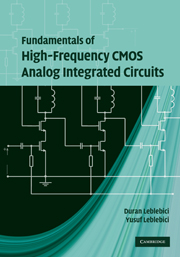Book contents
- Frontmatter
- Contents
- Preface
- 1 Components of analog CMOS ICs
- 2 Basic MOS amplifiers: DC and low-frequency behavior
- 3 High-frequency behavior of basic amplifiers
- 4 Frequency-selective RF circuits
- 5 L-C oscillators
- 6 Analog–digital interface and system-level design considerations
- Appendix A Mobility degradation due to the transversal field
- Appendix B Characteristic curves and parameters of AMS 0.35 micron NMOS and PMOS transistors
- Appendix C BSIM3-v3 parameters of AMS 0.35 micron NMOS and PMOS transistors
- Appendix D Current sources and current mirrors
- References
- Index
4 - Frequency-selective RF circuits
Published online by Cambridge University Press: 05 June 2012
- Frontmatter
- Contents
- Preface
- 1 Components of analog CMOS ICs
- 2 Basic MOS amplifiers: DC and low-frequency behavior
- 3 High-frequency behavior of basic amplifiers
- 4 Frequency-selective RF circuits
- 5 L-C oscillators
- 6 Analog–digital interface and system-level design considerations
- Appendix A Mobility degradation due to the transversal field
- Appendix B Characteristic curves and parameters of AMS 0.35 micron NMOS and PMOS transistors
- Appendix C BSIM3-v3 parameters of AMS 0.35 micron NMOS and PMOS transistors
- Appendix D Current sources and current mirrors
- References
- Index
Summary
During the early days of radio design, the tuned amplifier was one of the most important subjects of electronic engineering. It was used as the input RF amplifier of radio receivers tunable in a certain frequency range and as an intermediate frequency (IF) amplifier tuned to a fixed frequency. From the 1930s to 1950s RF amplifiers using electron tubes were one of the most important and interesting research areas of electronics engineering and were investigated in depth. TV and all other wireless systems were other application areas for tuned amplifiers.
After the emergence of transistor circuits in the 1950s, the knowledge already acquired was sufficient for transistorized tuned amplifiers, because the frequency range was still limited to several hundreds of MHz. Active filters, one of the benefits of analog ICs, largely replaced another class of frequency-selective circuits, i.e. L-C filters. As a result of these developments the importance of inductors and circuits containing inductors decreased and eventually these subjects disappeared from many electronic engineering curricula and textbooks.
The rapid expansion of wireless personal communication and data communication during the recent decade, and the developments in IC technology that extended the operation frequencies into the GHz range, resulted in the “re-birth” of frequency-selective circuits containing inductors.
- Type
- Chapter
- Information
- Fundamentals of High-Frequency CMOS Analog Integrated Circuits , pp. 155 - 236Publisher: Cambridge University PressPrint publication year: 2009

